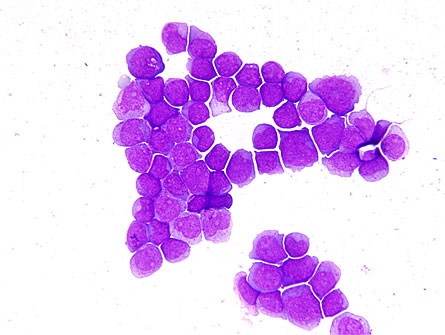- More than 2 years ago
For the first time, a complete cancer genome, and incidentally a complete female genome, has been decoded, scientists report online Nov. 5 in Nature. In a study made possible by faster, cheaper and more sensitive methods for sequencing DNA, the researchers pinpoint eight new genes that may cause a cell to turn cancerous.

“Since cancer is a disease of the genome, this newfound ability to determine the complete DNA sequence of a cancer cell is enormously powerful,” comments Francis Collins, a geneticist and former director of the National Human Genome Research Institute in Bethesda, Md., a group that raced to sequence the first entire human genome.
“We need to know the genetic rules of cancer,” says coauthor Timothy Ley of Washington University in St. Louis. Ley and colleagues read each of the 3 billion building blocks of DNA from tumor cells in a woman with acute myeloid leukemia, or AML, a highly malignant form of blood and bone marrow cancer. Then the team compared the long string of code with one taken from noncancerous skin cells from the same woman.
This new sequencing technology, called massively parallel sequencing, makes it possible to compare the normal DNA sequence to the cancerous DNA sequence in the same patient. That, in turn, allows researchers to find individual DNA bases — the needles in a haystack of 3 billion pieces of straw — that had mutated in the cancerous cells.
Kevin Shannon, director of the Medical Scientist Training Program at the University of California, San Francisco, studies the genes that may lead to leukemia and calls this work “a major achievement,” one that is “remarkable for its rigor and precision.”
None of the researchers knew what to expect for the number of mutated genes in the cancerous cells. “We were flying blind,” says Ley. But after rigorously pruning the data to keep only the most significant mutations, the researchers identified 10 mutations, eight of which were in genes never before implicated in AML. Of these eight new mutations, none were found to be mutated in tumors from other, smaller-scale studies, suggesting that individual AML cases are distinct.
It may be that the disease is so specific doctors will need to sequence each individual with AML to determine the best course of treatment, says coauthor Elaine Mardis, also of Washington University.
At the same time, because those earlier studies did not sequence the entire genome, and because this new study had a sample size of only one patient, it is too early to tell if AML has different kinds of mutations in different patients.
So, equally possible is that common mutations in similar groups of genes may contribute to AML. Discovery of these gene networks could allow doctors to use these common pathways of disease to treat patients similarly.
“It’s fun to speculate,” Maris says, “but we just don’t know.”
Understanding the genetic basis of cancer could lead to highly personalized treatments, says Mardis. “Right now, they’re all treated the same way they were 25 years ago,” she says of AML patients. It would be nice, Mardis says, if doctors could tell their patients, “Here’s what we know about your disease, and here are your best treatment options.”
Although scientists read every base pair in the patient’s genome, they only analyzed mutations in the DNA sequences that produce proteins, an estimated meager 1 to 2 percent of the human genome. To find mutations in other regions called intergenic DNA will require intensive statistical analyses. “We haven’t finished the job,” says Ley.
Because this study was designed to find genes that were mutated in a cancer genome, researchers omitted the DNA sequences from the sex chromosomes, the Xs and Ys, when making comparisons. Little is known about the differences between a male and a female genome.
The research team currently has funding to support more cancer genome sequences in the next few years. “What we need are thousands of genomes from each cancer,” says Ley. “We’ve already started a second patient, and are nearly finished, but our hopes are to do more.”






